People. Process. Technology: It’s served as the mantra of management consultants, business leaders, and B-school students for decades. But allow us for a moment to play the role of the disruptor — the People, Process, and Technology (P/P/T) mantra is wrong. Maybe not entirely wrong, but at a minimum, it is outdated and limited in its view of the modern business enterprise. Just considering P/P/T is not enough.
To paraphrase songwriters Mark Wright and Ronnie Rogers, we’re talking about the Big D, and we don’t mean Dallas. The “D” in this case is Data. In today’s business world, no company — from a global mega-corporation to the entrepreneur in the basement with an idea to change the world — can exist without data. From customer names and addresses, to product dimensions, to service descriptions, to cash balances, to projected spend and collections, to shipment times, to employee identities, to number of followers and beyond, data is everywhere — and all companies depend on it.
Yet as critical as data is, it cannot stand alone. It needs Technology to move and store it. Processes to control and manage it. People to use and gain insights from it. This disruptor is not suggesting the triangle of P/P/T is unimportant. Not in the least. Rather, we’re suggesting there is a better P/P/T/D framework that provides a more complete and valuable picture of the whole enterprise, enabling all-encompassing decision-making and comprehensive strategies for the future.
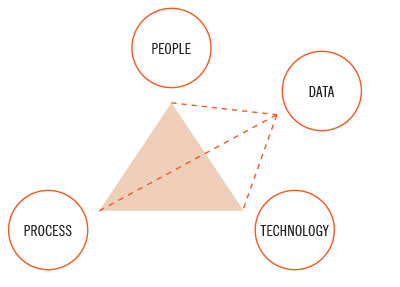
THE P/P/T/D PYRAMID
The classic P/P/T framework, often referred to as the “golden triangle,” is two-dimensional. It doesn’t account for the fact that data continues to emerge in businesses and serves as a driving force for future business capabilities, innovation, and growth.
Business has evolved. Collecting and providing information has emerged as a core business service and, as such, we need to evolve our two-dimensional triangle into a three-dimensional model that can be viewed across all axes. Think of the combined framework as a triangular pyramid — a four-sided, four-pointed polyhedron — with each point representing a fractional perspective but contributing to the stability of the whole. Remove any point and the structure’s balance becomes precarious. Consider only three of the four points in your organizational decisions and policies, and your view is limited to a partial picture of the whole.
Many books have been written about Process. And even more have been written about People, Technology, and Data. And while there are far too many details to include in this article, it’s important to review the basics of each — as well as the ramifications of ignoring them in your decision-making — before delving deeper into the concept of an expanded P/P/T/D framework.
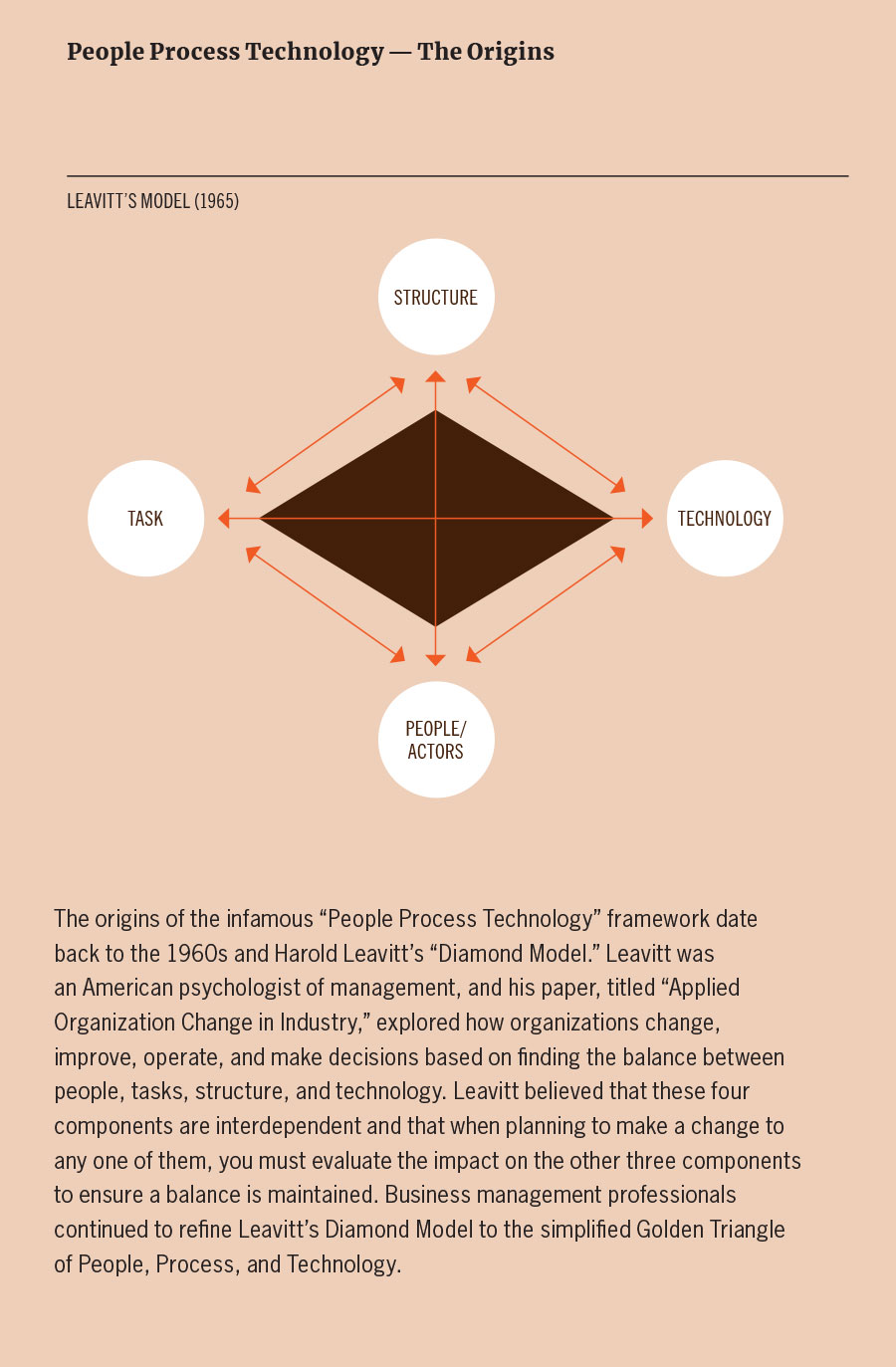
People Process Technology — The Origins
LEAVITT’S MODEL (1965)
- TASK
- STRUCTURE
- TECHNOLOGY
- PEOPLE/ ACTORS
The origins of the infamous “People Process Technology” framework date back to the 1960s and Harold Leavitt’s “Diamond Model.” Leavitt was an American psychologist of management, and his paper, titled “Applied Organization Change in Industry,” explored how organizations change, improve, operate, and make decisions based on finding the balance between people, tasks, structure, and technology. Leavitt believed that these four components are interdependent and that when planning to make a change to any one of them, you must evaluate the impact on the other three components to ensure a balance is maintained. Business management professionals continued to refine Leavitt’s Diamond Model to the simplified Golden Triangle of People, Process, and Technology.
People
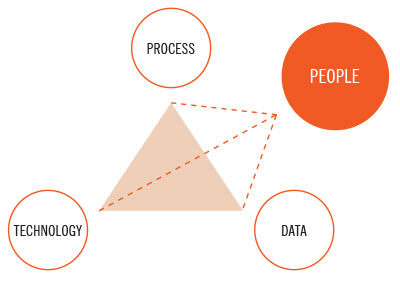
People are the heart and consciousness and the living soul of every organization. They are the reason an enterprise exists. People have skills, capabilities, desires, potential, limits, moods, and yes, feelings. People do the work. They execute processes and utilize the technology. Without them, nothing can happen.
Companies must hire the correct people with the right qualifications, experience, and skill set to ensure success. In addition to employees, the people connected to a company include contractors, customers, vendors, regulators, users, advocates (and trolls), leaders, followers, and partners, among countless others. Engaging with people in many roles should be taken into consideration.
What are the potential impacts if you ignore People and only consider P/T/D?
- Mismatched roles and skills
- High employee turnover
- Unmotivated/uninspired/unproductive workforce
- Low product adoption rates and ratings
- Poorly designed user experiences
- Decreased sales
- Increased regulatory and compliance risk
Process
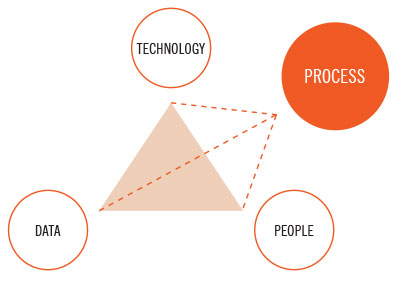 Processes are the rules, the motor controls, the structure, and the muscles for action (or inaction) by people and technology. Process is the means by which things get done.
Processes are the rules, the motor controls, the structure, and the muscles for action (or inaction) by people and technology. Process is the means by which things get done.
Processes may be formalized through rules embedded deep in application logic, in configured workflows, in standard operating procedures (SOPs) and training manuals, and in dusty binders full of process diagrams sitting on a shelf. Processes may also be informal, including reactions to unforeseen challenges and opportunities, maturation of support and operations for new pilot products, etc. A healthy process environment is a balance of formal and informal processes that both support the organization’s goals and serve as a mechanism for continuous improvement as the business evolves.
The high-level process landscape and individual process steps may vary widely across industries, organization maturity, enterprise scale, and culture. Examples of processes you may see at your company include:
- Establishing a plan and setting strategic goals for the future
- Resetting a frustrated customer’s password
- Onboarding your new data scientist with the access and tools needed to excel
- Testing the latest sprints enhanced capabilities before deploying to production
- Relocating offices to accommodate a more remote workforce
- Reconciling orders, invoices, and receipts
- Selecting a vendor for your expanded product marketing campaign
The list goes on. There are millions of processes and process variants across the business world. Regardless of your company’s profile, maturity, scale, product line, services, industry, etc., processes should be taken into consideration for all material decisions.
What are the potential impacts if you ignore Process and only consider T/D/P?
- Redundant steps leading to lower productivity and increased cost
- Poorly defined tasks and inconsistent execution resulting in increased errors and rework
- Failure to identify and implement automated processes
- Automating processes that need human involvement
- Nonexistent or misaligned process measures resulting in misguided attention and investment
Technology
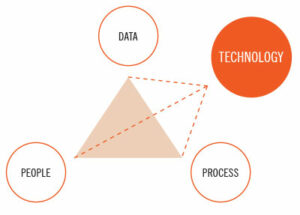
Technology is the brain and the nervous system of an enterprise — receiving and processing inputs to send signals used by people and processes, and to generate more inputs for additional processing. Think of the technology “brain and nervous system” as the ever-changing and evolving collection of tools in the enterprise toolbox.
While people and processes have changed over the past few decades, the quantum leaps have been in Technology and Data. Technology from mainframes to personal computers, to the internet, to mobile, to Robotic Process Automation (RPA), to Artificial Intelligence (AI), to Machine Learning (ML), and beyond, have drastically changed organizations’ capabilities and led to efficiency and growth. Technology surrounds us. It changes at a rapid pace. For current state operations and future state plans, technology is a critical consideration.
What are the potential impacts if you ignore Technology and only consider D/P/P?
- Living with legacy technical debt and associated costs Digging a deeper pit of technical debt
- Effect on time to market with new products
- Setting unrealistic expectations with customers and stakeholders on capabilities, timing, and value
- Undertaking a digital transformation
- Security
Data
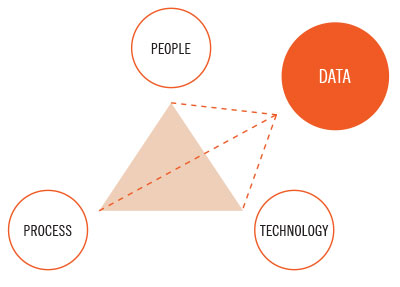 If Technology is the brain, Process the muscle, and People the heart — then Data is the lifeblood. Data is the current circulating through the system that provides nutrients and enables the whole enterprise to survive and thrive. And while Technology enables the storage, transmission, processing, analysis, and even the existence of Data, Technology, and Data are not the same; no more than People, who enable the steps of a process, are the same as Processes.
If Technology is the brain, Process the muscle, and People the heart — then Data is the lifeblood. Data is the current circulating through the system that provides nutrients and enables the whole enterprise to survive and thrive. And while Technology enables the storage, transmission, processing, analysis, and even the existence of Data, Technology, and Data are not the same; no more than People, who enable the steps of a process, are the same as Processes.
As Technology has changed by leaps and bounds, so too has Data. The velocity of change in content and volume of data is bewildering: From a 176 x 176-pixel picture of a baby in 1957 to dramatic Webb telescope images taken millions of miles across the universe in 2022. From the first YouTube video posted in 2005 to an estimated 14-plus billion YouTube videos posted online as of 2020. More data was created between 2018 and 2022 than in all of prior human history. The numbers are even larger today.
Data is the current circulating through the system that provides nutrients and enables the whole enterprise to survive and thrive.
Data is collected, shared, analyzed, used, generated, and stored everywhere. Purchases. Sales. Returns. Social media. Computers. Satellites. Phones. Cars. Refrigerators. Watches. Doorbells. Soda machines. If you’re not thinking about Data, you’re overlooking dimensions critical to today’s business reality. Data is at the core of all operational, tactical, and strategic decision-making.
What are the potential impacts if you ignore Data and only consider P/P/T?
- Multiple systems with the same but really not the same customer data
- Failure to comply with growing personal data privacy regulations around the world (e.g., General Data Protection Regulation (GDPR), China Personal Information Protection Law (PIPL), etc.)
- Underutilizing your most valuable asset (likely not on your balance sheet)
- Making transactional, operational, and strategic decisions based on incomplete and inaccurate information
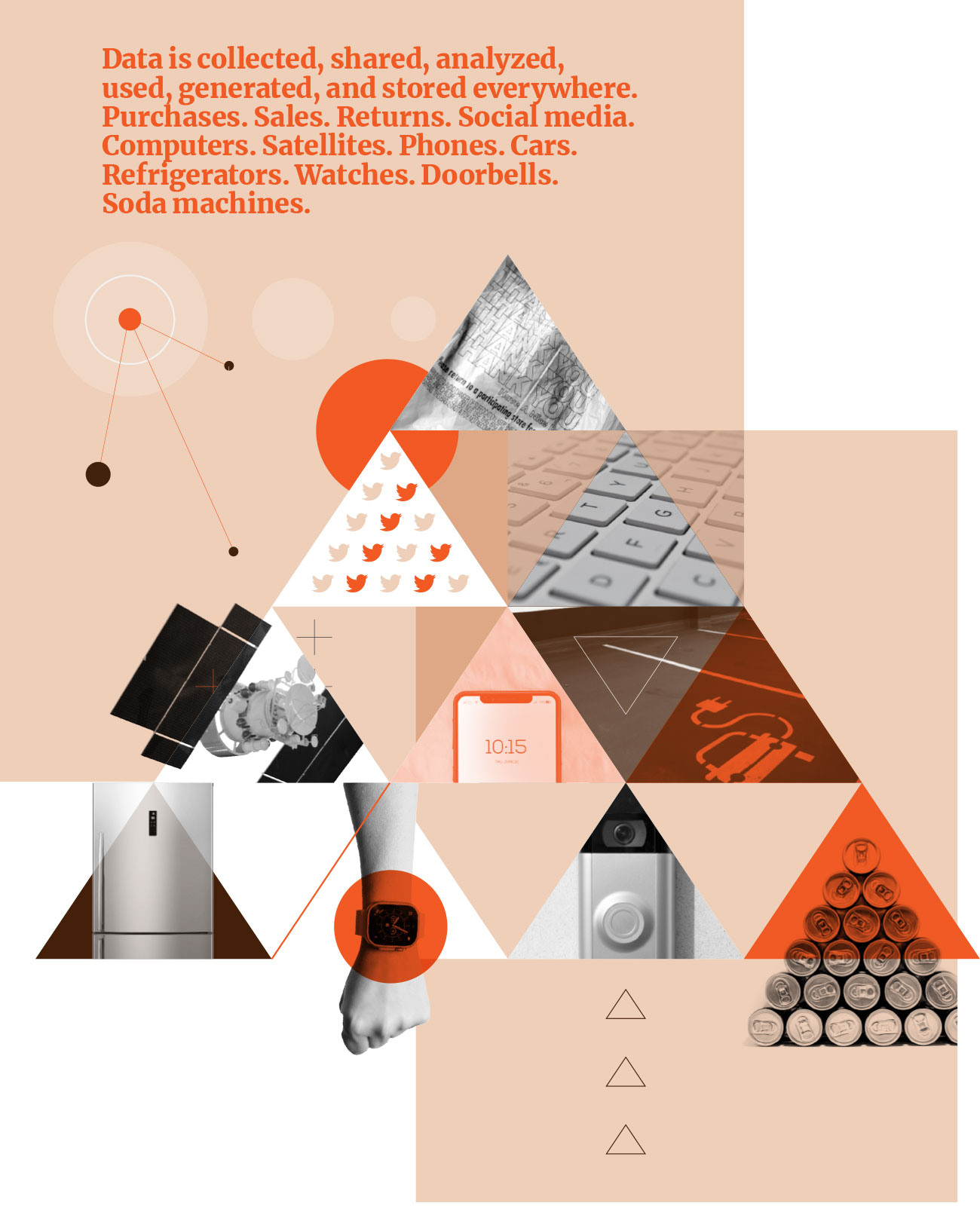
Soda machines.
Putting the Pyramid Into Practice
While you likely have experience using the P/P/T triangle framework, you may still be wondering how best to incorporate Data. To illustrate, here are three business scenarios — transformations, new product launches, and mergers and acquisitions — that are ideal for adding Data to your People, Process, and Technology framework, as well as the related potential perils of not considering Data.
Soda machines.
TRANSFORMATIONS
Many enterprise initiatives can be considered “Transformational.” As a reader of a business journal, you likely have experienced one or more of the following scenarios: A large-scale technology implementation. Maybe an enterprise resource planning (ERP). Or a human resources information system (HRIS). Or a customer relationship management (CRM) tool. Or an inventory control system. Or a general ledger. Or going all-digital. Or fill in the blank for your personal transformation story.
Here are a few examples of what could go wrong with a Transformation without considering Data:
Migrating data from current system(s) to a shiny new target system without extensive data justification and cleansing.
“Oh, that takes too long/costs too much. We’ll just move it over as it is today and clean up later so we can hit our deployment deadline.” Garbage in. Garbage out. You’ll likely be spending many years between this deployment and your next transformation fighting the same data quality problems that were used to justify the current transformation.
No plan for future storage of past historical master/transactional/analytics data.
“Oh, we don’t need that in our shiny new system. Let’s dump it as-is into our data lake (swamp) or save it off on tape/CD-ROM/floppy disk and put it in the basement.” History has special use cases — historical trend analysis, compliance, basis for predictive analytics, etc. — and requires thoughtfulness and intentionality in making those decisions.
No defined lines of communication, decision-making, and escalation for data.
“Oh, we’ll figure it out as we go.” Transformational efforts will spark hundreds if not thousands of data-related decisions that need to be made (e.g., common identifiers, hierarchy leveling, translation rules). Without well-understood and disciplined data governance within the transformation program (and the broader enterprise), you’ll likely end up with your technical developers, workstream leads, and PMO making strategic data decisions. They may get it right. Or not. It’s the “nots” you should worry about.
Global Industrial Product Manufacturer (Company X) HR/Payroll Transformation.
Company X’s HR/Payroll Transformation Roadmap targeted its design, migration of existing capabilities, and rollout of enhancements on a new HR platform for 12–18 months starting in early 2019. At the close of 2022, only a partial set of capabilities across a fraction of Company X’s global footprint had been fully deployed. While the causes for the delays are widespread, a core contributor is a failure to include global data definitions, quality, and governance (e.g., decision-making at the right time, place, and level) in the transformation testing and implementation plans. This resulted in program delays, rework, and the establishment of quick response teams to manually correct data issues preventing the normal and timely processing of payroll and basic HR transactions.
Failure to adequately include data in transformation planning and execution not only extended the overall timeline by years and costs millions of dollars in additional staffing, it also eroded the confidence of the workforce to provide basic services and accurate paychecks.
NEW PRODUCT LAUNCH
People, Process, Technology, and Data are all critical to launching a new product. Within the traditional P/P/T landscape, many companies and entrepreneurs assess the following: if they have the right people with the best qualifications to bring a product to market; if they have the correct processes in place to source vendors or materials; or if they have the best technology available to efficiently penetrate the market or satisfy consumers efficiently. However, Data plays a major role too. In fact, it is the main driver of all decisions being made and determines if the product launch will be successful. It determines the necessary qualifications in people, what the correct processes are, and how to decide on the best available technology.
A few examples of what could go wrong with a new product launch without considering Data:
Developing and launching a new product without drilling down into (and across) the real market conditions.
“My gut tells me this is good” or “Seems like something our customers would buy” won’t cut it. Taking advantage of a vast array of available data and readily available storage and analytical tools to get insights on market needs and behaviors for new and variations on existing products, data can help answer questions like: When should I launch? What’s the competition doing? How can I differentiate my product? What are customers buying? What are they willing to pay? Will I be profitable at that price point? You might get lucky, but not taking advantage of data could be the difference between success and catastrophic failure.
Assuming the current-state technology is scaled to handle the launch.
Whether your technology includes mobile, web, delivery routing, order picking, manufacturing, support call centers, or any other systems and networks used to get your product into your customers’ hands, you’ll have to use data to plan the capacity needed at launch and for subsequent growth. Do I have enough trucks? Can I run three shifts to build inventory? Can I process the anticipated order volume? What about returns? Do I have enough call center agents, interactive voice response (IVR), and artificial intelligence (AI) engine capacity? You can never answer all of the questions that you should be asking, but using data in advance can make your launch run more smoothly.
Uber Grocery Test Market
Uber’s goal is to provide the best grocery delivery experience for on-demand needs. To do this, the company established test markets for its pre-launch in order to understand its ability to service clients and bring in large data sets.
For people, Uber analyzed employee needs through data points such as driver availability and incentives, commissions, driver ratings, and peak hours. For process, the company looked at drive times, store availability, payment processing, and grocery store partnerships. Technology assessments covered grocery availability, grocery store pricing, ability to upload catalogs, and the number of users and grocery stores.
To tie it all together and ensure a successful product launch, Uber focused on the test market data. By looking at factors such as customer acquisition costs, customer retention, market demand, and monthly active users (MAU), analysts were able to display how successful and profitable the product launch would be. The company’s efficient use of people, process, technology, and data has proven successful. Since the launch, Uber has grown its grocery and retail operations by more than $4.5B globally and has penetrated markets in over 33 countries.
Exploring Oracle’s Acquisition of Cerner
Let’s take a look at one of the largest healthcare M&A deals focused on healthcare data — cloud giant Oracle’s $28.3B acquisition of electronic health records company, Cerner.
According to a study published by the Annals of Internal Medicine of approximately 100 million patient encounters with about 155,000 physicians from 417 health systems, physicians spent an average of 16 minutes and 14 seconds per encounter using EHRs [electronic health record systems]. This is a significant administrative burden on a physician’s ability to focus on driving better patient outcomes. While the deal between Oracle and Cerner aims to open a new world of opportunities in reducing this burden by proving better technology and processes, data is critical to achieving this goal. In order for Oracle and Cerner to be successful with this journey, they cannot only view their strategy based only upon People, Process, and Technology. Data will need to take center stage for decision-making as they dive headfirst into unleashing the interoperability of healthcare data with technology and databases while also maintaining patient privacy.
Larry Ellison, Chairman and Chief Technology Officer at Oracle, stated that “Oracle’s corporate mission expands to assume the responsibility to provide our over-worked medical professionals with a new generation of easier-to-use digital tools that enable access to information via a hands-free voice interface to secure cloud applications. Better information enables better treatment decisions resulting in better patient outcomes.”
By considering data, Oracle was able to penetrate a new market and help physicians generate better decisions for patients.
MERGERS AND ACQUISITIONS
Over the hopefully long life of a business, it is likely that the company may be acquired or will acquire another business, leading to the merger of people, process, technology, and data. When performed successfully, great things can emerge. The opposite, however, is far more likely. According to the Harvard Business Review, between 70 percent and 90 percent of mergers and acquisitions fail. From assessing the market for potential acquisition to doing due diligence, negotiating, and integrating, the role of Data is enormous.
A few examples of what could go wrong with a merger or an acquisition without considering Data:
Integrating aspects of operations without integrating the data backbone.
Mergers and acquisitions often aim to take advantage of economies of scale to reduce costs and increase company performance. When people and processes are reorganized and consolidated, it is crucial to understand how data is defined, connected, and measured. Often in organizations growing through M&A, systems are bolted on and simply added to the application stack, leading to duplicate and redundant data across the enterprise that further limits the trustworthiness, accuracy, and value of data insights. When people don’t know where to find accurate data or don’t trust what they do find, data-driven decision-making becomes an afterthought rather than the primary driver.
Delivering the customer value proposition while making a profit.
As you may have learned in Accounting 101, the formula for calculating profit is simple: Profit = Revenue – Expenses. While a simple formula, profitability is actually a lagging indicator measured days, weeks, or even months prior to the last period close. Reporting on the past is simple. Predicting the future is not. Building a crystal ball into the future requires understanding the business — which metrics, often in conflict, lead to higher profitability — and the data to apply to that understanding. Failure to consider and use the right historical and predictive data may result in the M&A never living up to its profitability potential or meeting its other critical objectives.
MERGERS AND ACQUISITIONS
Over the hopefully long life of a business, it is likely that the company may be acquired or will acquire another business, leading to the merger of people, process, technology, and data. When performed successfully, great things can emerge. The opposite, however, is far more likely. According to the Harvard Business Review, between 70 percent and 90 percent of mergers and acquisitions fail. From assessing the market for potential acquisition to doing due diligence, negotiating, and integrating, the role of Data is enormous.
A few examples of what could go wrong with a merger or an acquisition without considering Data:
Integrating aspects of operations without integrating the data backbone.
Mergers and acquisitions often aim to take advantage of economies of scale to reduce costs and increase company performance. When people and processes are reorganized and consolidated, it is crucial to understand how data is defined, connected, and measured. Often in organizations growing through M&A, systems are bolted on and simply added to the application stack, leading to duplicate and redundant data across the enterprise that further limits the trustworthiness, accuracy, and value of data insights. When people don’t know where to find accurate data or don’t trust what they do find, data-driven decision-making becomes an afterthought rather than the primary driver.
Delivering the customer value proposition while making a profit.
As you may have learned in Accounting 101, the formula for calculating profit is simple: Profit = Revenue – Expenses. While a simple formula, profitability is actually a lagging indicator measured days, weeks, or even months prior to the last period close. Reporting on the past is simple. Predicting the future is not. Building a crystal ball into the future requires understanding the business — which metrics, often in conflict, lead to higher profitability — and the data to apply to that understanding. Failure to consider and use the right historical and predictive data may result in the M&A never living up to its profitability potential or meeting its other critical objectives.
Exploring Oracle’s Acquisition of Cerner.
Let’s take a look at one of the largest healthcare M&A deals focused on healthcare data — cloud giant Oracle’s $28.3B acquisition of electronic health records company, Cerner.
According to a study published by the Annals of Internal Medicine of approximately 100 million patient encounters with about 155,000 physicians from 417 health systems, physicians spent an average of 16 minutes and 14 seconds per encounter using EHRs [electronic health record systems]. This is a significant administrative burden on a physician’s ability to focus on driving better patient outcomes. While the deal between Oracle and Cerner aims to open a new world of opportunities in reducing this burden by proving better technology and processes, data is critical to achieving this goal. In order for Oracle and Cerner to be successful with this journey, they cannot only view their strategy based only upon People, Process, and Technology. Data will need to take center stage for decision-making as they dive headfirst into unleashing the interoperability of healthcare data with technology and databases while also maintaining patient privacy.
Larry Ellison, Chairman and Chief Technology Officer at Oracle, stated that “Oracle’s corporate mission expands to assume the responsibility to provide our over-worked medical professionals with a new generation of easier-to-use digital tools that enable access to information via a hands-free voice interface to secure cloud applications. Better information enables better treatment decisions resulting in better patient outcomes.”
By considering data, Oracle was able to penetrate a new market and help physicians generate better decisions for patients.
Final Thoughts
We’ve all been in the conference room — face-to-face, virtual, or hybrid — and someone picks up a pen and writes three words on the whiteboard — People, Process, and Technology. The Big D — Data — is not on the board. (It wasn’t too many years ago that “People” was left off the list too.)
When mapping out your next opportunity or challenge, adding the D to your normal P/P/T triangle framework will provide an extra, critical dimension to make your framework a more stable P/P/T/D pyramid — and, ultimately, your results more extensive and valuable. In the end, the modern enterprise cannot operate and thrive without People, Process, Technology, and Data.
